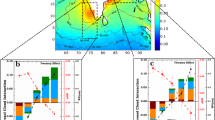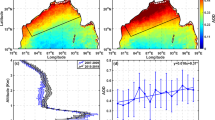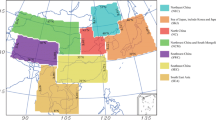Abstract
The present study attempts to identify the land - ocean contrast in cloud - aerosol relation during lightning and non-lightning days and its effect on subsequent precipitation pattern. The thermal hypothesis in view of Convective Available Potential Energy (CAPE) behind the land - ocean contrast is observed to be insignificant in the present study region. The result shows that the lightning activities are significantly and positively correlated with aerosols over both land and ocean in case of low aerosol loading whereas for high aerosol loading the correlation is significant but, only over land. The study attempts to comprehend the mechanism through which the aerosol and lightning interact using the concept of aerosol indirect effect that includes the study of cloud effective radius, cloud fraction and precipitation rate. The result shows that the increase in lightning activity over ocean might have been caused due to the first aerosol indirect effect, while over land the aerosol indirect effect might have been suppressed due to lightning. Thus, depending on the region and relation between cloud parameters it is observed that the precipitation rate decreases (increases) over ocean during lightning (non-lightning) days. On the other hand during non-lightning days, the precipitation rate decreases over land.
Similar content being viewed by others
References
Albrecht, B., 1989: Aerosols, cloud microphysics and fractional cloudiness. Science, 245, 1227–1230.
Andreae, M. O., 2009: Correlation between cloud condensation nuclei concentration and aerosol optical thickness in remote and polluted regions. Atmos. Chem. Phys., 9, 543–556.
Andreae, M. O., D. Rosenfeld, P. Artaxo, A. A. Costa, G. P. Frank, K. M. Longo, and M. A. F. Silva-Dias, 2004: Smoking rain clouds over the Amazon. Science, 303, 1337–1342.
Benmoshe, N., and A. P. Khain, 2014: The effects of turbulence on the microphysics of mixed-phase deep convective clouds investigated with a 2-D cloud model with spectral bin microphysics. J. Geophys. Res-Atmos., 119, 207–221.
Black, R. A., and J. Hallett, 1986: Observations of the distribution of ice in hurricanes. J. Atmos. Sci., 43, 802–822.
Boccippio, D. J., and S. J. Goodman, 2000: Regional differences in tropical lightning distributions. J. Appl. Meteorol., 39, 2231–2248.
Boccippio, D. J., C. Wong, E. R. Williams, R. Boldi, H. Christian, and S. J. Goodman, 1998: Global validation of single station Schumann resonance lightning location. J. Atmos. Sol-Terr. Phy., 60, 701–722.
Breon, F. M., D. Tanre, and S. Generoso, 2002: Aerosol effect on cloud droplet size monitored from satellite. Science, 295, 834–838.
Chaudhuri, S., and A. Middey, 2013: Effect of meteorological parameters and environmental pollution on thunderstorm and lightning activity over an urban metropolis of India. Urban Clim., 3, 67–75.
Christian, H. J., and Coauthors, 1999: Global frequency and distribution of lightning as observed by the Optical Transient Detector (OTD). Proc. 11th Int. Conf. Atmos. Electricity, NASA, Guntersville, 726–729.
Chronis, T. G., S. J. Goodman, D. Cecil, D. Buechler, F.J. Robertson, J. Pittman, 2008: Global lightning activity from the ENSO perspective. Geophys. Res. Lett., 35, L19804.
Compo, G. P., and Coauthors, 2011: The Twentieth Century Reanalysis Project. Quart. J. Roy. Meteorol. Soc., 137, 1–28.
Feingold, G., W. Eberhard, D. Veron, and M. Previdi, 2003: First measurements of the Twomey indirect effect using ground-based remote sensors. Geophys. Res. Lett., 30, 1287, doi:10.1029/2002GL016633,2003.
Fullekrug, M., C. Price, Y. Yair, and E. R. Williams, 2002: Intense oceanic lightning. Ann. Geophys., 20, 133–137.
Gauthier, M. L., W. A. Petersen, L. D. Carey, and H. J. Christian Jr., 2006: Relationship between cloud-to-ground lightning and precipitation ice mass: a radar study over Houston. Geophys. Res. Lett., 33, L20803.
Hidayat, S., and M. Ishii, 1998: Spatial and temporal distribution of lightning activity around Java. J. Geophys. Res., 103(D12), 14001–14009.
Kandalgaonkar, S. S., J. R. Kulkarni, M. I. R. Tinmaker, and M. K. Kulkarni, 2010: Land-ocean contrasts in lightning activity over the Indian region. Int. J. Climatol., 30, 137–145.
Kar, S. K., and Y. A. Liou, 2014: Analysis of cloud-to-ground lightning and its relation with surface pollutants over Taipei, Taiwan. Ann. Geophys., 32, 1–8.
Kar, S. K., Y. A. Liou, and K. J. Ha, 2009: Aerosol effects on the enhancement of cloud-to-ground lightning over major urban areas of South Korea. Atmos. Res., 92, 80–87.
Koren, I., Y. J. Kaufman, D. Rosenfeld, L. A. Remer, and Y. Rudich, 2005: Aerosol invigoration and restructuring of Atlantic convective clouds. Geophys. Res. Lett., 32, L14828, doi:10.1029/2005GL023187.
Lee, H., J. J. Baik, and J. Y. Han, 2014: Effects of turbulence on mixedphase deep convective clouds under different basic-state winds and aerosol concentrations. J. Geophys. Res-Atmos., 119, 13506–13525.
Lelieveld, J., and Coauthors, 2001: The Indian Ocean experiment: widespread air pollution from South and South-East Asia. Science, 291, 1031–1036.
Liu, D. X., X. S. Qie, Y. J. Xiong, and G. L. Feng, 2011: Evolution of the total lightning activity in a leading-line and trailing stratiform mesoscale convective system over Beijing. Adv. Atmos. Sci., 28, 866–878.
Liu, Z., D. Ostrenga, W. Teng, and S. Kempler, 2012: Tropical Precipitation Measuring Mission (TRMM) precipitation data and services for research and applications. Bull. Am. Meteorol. Soc., 93, 1317–1325.
MacGorman, D. R., D. W. Burgess, V. Mazur, W. D. Rust, W. L. Taylor, and B. C. Johnson, 1989: Lightning rates relative to tornadic storm evolution on 22 May 1981. J. Atmos. Sci., 46, 221–251.
Massie, S. T., O. Torres, and S. J. Smith, 2004: Total Ozone Mapping Spectrometer (TOMS) observations of increases in Asian aerosol in winter from 1979 to 2000. J. Geophys. Res., 109, D18211.
Middey, A., and S. Chaudhuri, 2013: The reciprocal relation between lightning and pollution and their impact over Kolkata, India. Environ. Sci. Pollut. Res., 20, 3133–3139.
Orville, R. E., and R. W. Henderson, 1986: Global distribution of midnight lightning: December 1977 to August 1978. Mon. Wea. Rev., 114, 2640–2653.
Orville, R. E., G. Huffines, J. Nielsen-Gammon, R. Zhang, B. Ely, S. M. Steiger, S. Phillips, S. Allen, W. Read, 2001: Enhancement of cloud-to-ground lightning over Houston, Texas. Geophys. Res. Lett., 28, 2597–2600.
Petersen, W. A., and S. A. Rutledge, 1998: On the relationship between cloud-to-ground lightning and convective rainfall. J. Geophys. Res., 103, 14025–14040.
Pinto, Jr. O., I. R. C. A. Pinto, and K. P. Naccarato, 2007: Maximum cloud to ground lightning flash densities observed by lightning location systems in the tropical region: A Review. Geophys. Res. Lett., 84, 189–200.
Platnick, S., M. D. King, S. A. Ackerman, W. P. Menze, B. A. Baum, J. C. Riedi, and R. A. Frey, 2003: The MODIS cloud products: algorithms and examplesfrom terra. IEEE T Geosci Remote, 41, 459–473.
Qie, X. S., C. M. Guo, M. H. Yan, and G. S. Zhang, 1993: Lightning data and study of thunderstorm nowcasting. Acta Meteorol. Sin., 7, 244–256.
Ramanathan, V., P. J. Crutzen, J. T. Kiehl, and D. Rosenfeld, 2001: Atmosphere, climate, and the hydrological cycle. Science, 294, 2119–2124.
Remer, L. A., and Coauthors, 2005: The MODIS aerosol algorithm, products, and validation. J. Atmos. Sci., 62, 947–973.
Rogers, R. R., and M. K. Yau, 1989: A Short Course in Cloud Physics. Pergamon Press, 304 pp.
Schultz, C. J., W. A. Petersen, and L. D. Carey, 2011: Lightning and severe weather: a comparison between total and cloud-to-ground lightning trends. Wea. Forecasting, 26, 744–755.
Singh, D., A. K. Singh, R. P. Patel, R. P. Singh, B. Venadhari, and M. Mukherjee, 2008: Thunderstorm, lightning, sprites and magnetospheric whistler mode radio wave. Surv. Geophys., 29, 499–551.
Snee, R. D., and C. G. Pfeifer, 2006: Histograms. Encyclopedia. Stat. Sci., doi:10.1002/0471667196.ess0952.pub2.
Stallins, J. A., M. L. Bentley, and L. S. Rose, 2006: Cloud-to-ground patterns for Atlanta, Georgia (USA) from 1992 to 2003. Clim. Res., 30, 99–112.
Tang, J., P. Wang, L. J. Mickley, X. Xia, H. Hong Liao, X. Yue, L. Sun, J. Xia, 2014: Positive relationship between liquid cloud droplet effective radius and aerosol optical depth over Eastern China from satellite data. Atmos. Environ., 84, 244–253.
Turman, B. N., and B. C. Edgar, 1982: Global lightning distributions at dawn and dusk. J. Geophys. Res., 87, 1191–1206.
Twomey, S., 1977: The influence of pollution on the shortwave albedo of clouds. J. Atmos. Sci., 34, 1149–1152.
Ushio, T., S. J. Heckman, D. J. Boccippio, H. J. Christian, Z. I. Kawasaki, 2001: A survey of thunderstorm flash rates compared to cloud top height using TRMM satellite data. J. Geophys. Res., 106, 24089–24095.
van den Heever, S. C., and W. R. Cotton, 2007: Urban aerosol impacts on downwind convective storms. J. Appl. Meteorol. Climatol., 46, 828–850.
van den Heever, S. C., G. L. Stephens, and N. B. Wood, 2011: Aerosol indirect effects on tropical convection characteristics under conditions of radiativeconvective equilibrium. J. Atmos. Sci., 68, 699–718.
van den Heever, S. C., G. Carrio, W. R. Cotton, P. J. DeMott, and A. J. Prenni, 2006: Impacts of nucleating aerosol on Florida convection. Part I: mesoscale simulations. J. Atmos. Sci. 63, 1752–1775.
Whitaker, J. S., G. P. Compo, X. Wei, and T. M. Hamill, 2004: Reanalysis without radiosondes using ensemble data assimilation. Mon. Wea. Rev., 132, 1190–1200.
Wiens, K. C., S. A. Rutledge, and S. A. Tessendorf, 2005: The 29 June 2000: supercell observed during STEPS. Part II: lightning and charge structure. J. Atmos. Sci., 62, 4151–4177.
Wilks, D., 2011: Statistical Methods in the Atmospheric Sciences. International Geophysics, Academic Press, 704 pp.
Williams, E. R., 1989: The tripole structure of thunderstorms. J. Geophys. Res, 94, 13151–13167.
Williams, E. R., and S. Stanfill, 2002: The physical origin of the land-ocean contrast in lightning activity. C. R. Phys., 3, 1277–1292.
Williams, E. R., T. Chan, and D. Boccippio, 2004: Islands as miniature continents: another look at the land-ocean contrast. J. Geophys. Res., 109, D16210, doi:10.1029/2003JD003833.
Williams, E. R., K. Rothkin, D. Stevenson, and D. Boccippio, 2000: Global lightning variations caused by changes in thunderstorm flash rate and by changes in the number of thunderstorms. J. Appl. Met., 39, 2223–2230.
Williams, E. R., D. Rosenfeld, N. Madden, C. Labrada, J. Gerlach, and L. Atkinson, 1999: The role of boundary layer aerosol in the vertical development of precipitation and electrification: another look at the contrast between lightning over land and over ocean. Preprints, 11th Int. Conf. Atmos. Electricity, Guntersville, AL, 754–757.
Williams, E. R., S. A. Rutledge, S. G. Geotis, N. O. Renno, S. A. Rutledge, E. Rasmussen, and T. Rickenbach, 1992: A radar and electrical study of tropical “hot towers.” J. Atmos. Sci., 49, 1386–1395.
Williams, E. R., and Coauthors, 2002: Contrasting convective regimes over the Amazon: implications for cloud electrification. J. Geophys. Res., 107, D20, doi:10.1029/2001JD000380.
Yuan, T., L. A. Remer, K. E. Pickering, and H. Yu, 2011: Observational evidence of aerosol enhancement of lightning activity and convective invigoration. Geophys. Res. Lett., 38, L04701.
Ziegler, C. L., D. R. MacGorman, P. S. Ray, and J. E. Dye, 1991: A model evaluation of non inductive graupel-ice charging in the early electrification of a mountain thunderstorm. J. Geophys. Res., 96, 12833–12855.
Zipser, E., and K. Lutz, 1994: The vertical profile of radar reflectivity of convective cells: A strong indicator of storm intensity and lightning probability? Mon. Wea. Rev., 122, 1751–1759.
Author information
Authors and Affiliations
Corresponding author
Rights and permissions
About this article
Cite this article
Pal, J., Chaudhuri, S., Chowdhury, A.R. et al. Cloud — Aerosol interaction during lightning activity over land and ocean: Precipitation pattern assessment. Asia-Pacific J Atmos Sci 52, 251–261 (2016). https://doi.org/10.1007/s13143-015-0087-0
Received:
Accepted:
Published:
Issue Date:
DOI: https://doi.org/10.1007/s13143-015-0087-0




